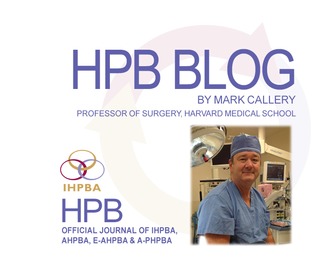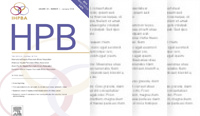International Hepato-Pancreato-Biliary Association
HPB Blog, May 2015

The May 2015 issue of HPB offers splendid high-quality variety through one systematic review and eleven original articles from around the globe. Before you dive in however, take a minute to read Professor James Garden’s overview summary of your “Journal on the rise”. He emphasizes our commitment to quality from submitted manuscripts through to efficient but thorough editorial review and timely publication. Citations, article downloads, and innovative website offerings all reflect that the international interest in and readership of HPB continue to mature and grow.
With expansion of axial imaging, more and more pancreatic cystic lesions are being identified. The real question is whether any such lesion, symptomatic or not, is merely a nuisance or a true threat of being or becoming malignant. Endoscopic ultrasonography with fine-needle aspiration (EUS-FNA) for cyst fluid cytology and chemistry is a mainstay of evaluating pancreatic cystic lesions. Should this approach include analysis for DNA and molecular abnormalities to enhance sensitivity and specificity for cancer? Amy Gillis and colleagues from Dublin, Ireland tackle this question in a top-flight systematic review.
Pancreas enthusiasts will also enjoy several practical original articles too. Christopher Shubert and team from the Mayo Clinic identify risk categories for pancreaticoduodenectomy based on a patient’s diagnosis. With the goal of pre-operative risk stratification being to minimize individual patient morbidity and mortality, such a paper is highly relevant. The authors correctly suggest that future outcomes studies and performance measures should include diagnosis-specific risk stratification. For daily clinical practice, such an approach can help mitigate inherent risks and help you allocate resources effectively. For your update on total pancreatectomy (TP), enjoy the 25 year perspective offered by Max Almond and colleagues from Birmingham, UK. You’ll learn a lot, but especially that indications are changing while clinical outcomes are improving. While TP is being performed more frequently, its proportion to partial pancreatectomies has not changed.
Sofia de la Serna and associates from the prolific liver cancer unit in Barcelona, Spain report on their 13 year experience with laparoscopic radiofrequency ablation (LRFA) for hepatocellular carcinoma (HCC). They show how LRFA is safe, feasible and very effective in carefully selected patients. Location, location, location! Stephen Wigmore offers a terrific highlight on the very interesting work of Mizutani and colleagues from Nagoya, Japan evaluating a potential hepato-protective effect of the herbal medicine inchinkoto. They extend their prior work in animals now to a prospective clinical study in which patients received the herbal medicine or not for 7 days prior to hepatectomy. A clear clinical hepatoprotective effect could not be identified (sample size?) but there was measurable induction of antioxidants in patients receiving inchinkoto. Other terrific liver topics in our May issue include analysis of multimodality therapy to optimize outcomes for patients with unresectable HCC (Pippa Newell et al, Portland, Oregon) and how body composition might impact outcomes of hepatectomy for colorectal cancer liver metastases (Toine Lodewick, et al, Maastricht, Netherlands).
Biliary surgery specialists and certainly practicing general surgeons offering cholecystectomy should pay careful notice to the paper by Nicolaj Stilling and colleagues from Denmark. By mining 5 years of a national database, the authors identified 139 patients who suffered iatrogenic bile duct injury for whom annotated clinical outcomes were available. As noted by Saxon Connor in his highlight, “the results make sober reading”. But Sax’s heart rate justifiably increases as he makes a call to action by us all against the catastrophe that is biliary injury. Don’t wait idly for these same results to occur again and again, but rise up and truly work to improve the standards and performance of cholecystectomy.
And so, enjoy your May HPB issue. We suspect you’ll agree with our Editor-in-Chief that HPB is indeed a journal on the rise. Perhaps in a month or two, we’ll have a new impact factor that indicates others around the world agree.
Mark P. Callery, MD
Harvard Medical School
Corporate Partners
If you are interested in becoming a Corporate Partner of the IHBPA please contact industry@ihpba.org
Find out more


